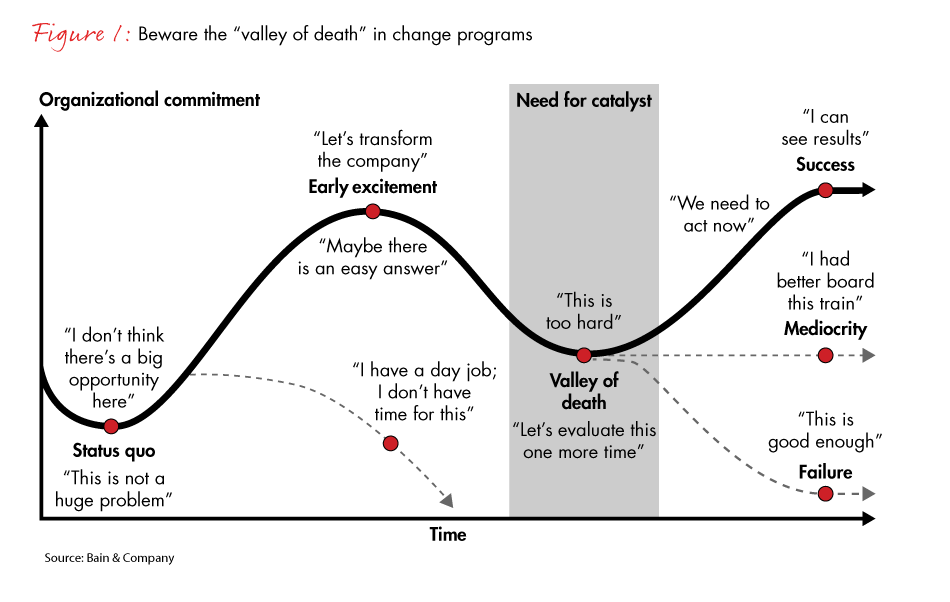Managing Change Blog
The CFO of a consumer products company was frustrated. He had campaigned hard to convince his CEO that he could help the company boost performance and build a better future if it made the investment to transform the finance function from a reporting mechanism to a strategic business adviser. A year later, he confided to a consultant that there was little to show for the effort and momentum was ebbing. He confessed that even he was having trouble putting time and energy into the effort because of other commitments. But the transformation remained a very important business and professional goal—potentially his signature achievement in this role.
This CFO’s tale of woe is all too common. Similar to many other change programs, the finance transformation was stuck in the “valley of death.” As is most common, this transformation program had started with a big bang. When programs launch, there’s a burst of energy as people take on assignments. The energy spreads as the details of the transformation emerge and people across the organization begin to see how the change can help the company compete better and give individual employees new ways to shine.
Then comes the valley of death. Nine to 18 months into the program, energy evaporates. People who were initially excited about participating in the transformation grow tired of the extra work and impatient with the lack of visible results. Enthusiasm gives way to cynicism. When change programs enter the valley of death, most of them never fully recover: Most either fail outright or deliver only mediocre results (Figure 1).

As we reminded the CFO, however, you can see that the valley of death is really a predictable phenomenon that companies can anticipate and manage. Indeed, we have developed a specialized response to the valley-of-death problem that we call the Bain Transformation Catalyst.
We use the catalyst to restore lost energy. At its core, every transformation program is a battle for organizational energy. When a change effort is new, senior leadership commitment is visible and people are excited, the transformation attracts energy. But change itself is disruptive, sapping energy across the organization. Inevitably, energy starts to flow away from the change effort, and that’s when you enter the valley of death.

Change Management Insights
Change management has been around for decades, but more than 70% of change efforts fail. Bain’s Results Delivery® insights help companies to predict, measure and manage risk, starting on day one.
We begin the reenergizing exercise by looking at the transformation itself to see if the goals and initiatives are still relevant. How have conditions outside the company changed? How has the company’s business changed? One of the first things we do is to get the senior leadership team together and ask them to recall what got them excited when they launched the transformation a year or more ago. What convinced them to jump into what they knew was going to be a very difficult undertaking? And do they still have that conviction and ambition?
The second step is to look at the design of the transformation effort to see if that’s where the trouble is. How the overall transformation and each of its initiatives are organized and operated can contribute to energy loss. Is senior leadership still involved and committed? Do initiative teams have adequate resources? Is the organization identifying key risks and mitigating them? Also, we check to see if initiative teams still have a clear idea of top priorities and if they are spending time on activities that produce no tangible results. These are major energy drains. Once we finish diagnosing the causes of the energy crisis, we have three choices: Stay the course, realign, or restart.
Here’s how the process worked for a large global consumer products company. When we started the diagnostic, we learned that employees involved with the transformation were still excited about the original ambition. That was encouraging news. But the effort had bogged down because they were not seeing results from their efforts, they weren’t getting the right resources, and they saw that the CFO was not investing his time. Also, we learned that while the ultimate goal remained clear and compelling, the troops were unclear on the objectives for many of the initiatives on which they were working. They didn’t see how their work connected to making finance a strategic force rather than just a reporting mechanism. So people were just checking the boxes, just getting it done.
Ultimately, the solution was to realign the transformation effort to make it more focused and agile. The biggest change was to reduce the number of initiatives by 60% and articulate a clear vision of how each one would contribute to the overall transformation. The company cut down the size of the steering committee, made executives accountable for results and brought in some new leaders who dedicated their time to the effort and had specific performance goals. The transformation organization started using smaller teams that worked in sprints on projects that could achieve their goals in a couple of weeks.
In short order, the energy started flowing again. People saw that their work was yielding results. They saw that senior leaders were recommitted and engaged—including the CFO. The new leaders remained engaged because they could make decisions more quickly and actually spend less time on the transformation while having a greater impact. And, at last, the transformation is taking hold: Finance employees have been freed up from routine reporting tasks and are able to spend more of their time advising their internal clients. The CFO is happy, his team is energized, and the company is getting fresh ideas on ways to grow profitably. The valley of death is all but forgotten.
Ivan Hindshaw is a partner in Bain & Company's Los Angeles office, and he leads Bain's Results Delivery® and Consumer Products practices. Adrian Gruin is a New York-based principal in the Results Delivery practice.
